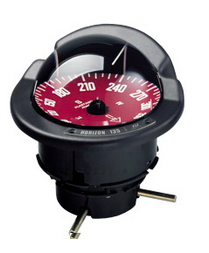There are times when you need to make you way down channels at night. Long offshore passages inevitably mean traveling at night. Certain extra precautions need to be taken into account when on the water in the dark.
Some gear is essential, like navigation lights and a good compass with light to steer by.
A large easy to read card on the compass makes a big difference to long hours concentrating at the helm. A red card with white letters is my favourite, with a 125 mm card being a nice size on a reasonable size boat. These are not an expensive upgrade when your old compass is faded and unreadable. Small compasses on power boats are great backup if your fancy GPS packs it in. Giving a crew member a compass course to steer by gives certainty to the course. Compass lights are notorious for failing so check your light action; a small torch taped to the compass is a good back up.
Make sure your port, starboard and stern lights are working and not obscured. A tri-colour on a yacht mast is seen from a greater distance and gets the bow lights out of the eyes.
Emergency battery operated navigation lights are cheap and easy to rig when the power goes out or if there are no nav lights aboard.
Plan your course before departing or nightfall, know what lights are available to guide you on the way and what flash signature they have.
Check your chart or plotter for dangers like reefs, headlands, moored boats or fish farms, all of which can spoil your happy times if you hit them, especially at speed. If you are uncertain of your position, slow down and have good look to orientate yourself. Double-check the chart, lights or any land that is obvious.
Night vision is the ability to see shapes in the dark; your eyes will adjust after a while and you can see quite well with practice. Night vision can be badly affected by having a white light or a torch turned on in the boat. Don’t let that helpful crew turn on any lights when doing tasks aboard.
By having a red or blue night light in the cabin or cockpit you can see to move around or make a cuppa without affecting the helmsman’s night vision.
Head torches can be a real problem when on the head of an uneducated crew member, so ensure everyone has a red light function on their head torch – or if they don’t, ensure they know to turn them off when looking aft to the driver.
Click here to see more on LED torches
A flexible chart light is essential on larger boats and means you can see the chart without having a cabin light on. Engine room lights are great to check and work on the engine when you are under way at night.
Spotlights and torches have come a long way in the last few years and have a long range, if you have a good one. This can be essential for entering port or mooring areas.
Depth sounders and radars are nice for night navigation if you have them aboard.
You can use the light trail from shore lights to give a passage route when you are entering a well light bay.
Keeping a sharp look out is your best plan to avoid collisions at night.
Beware of fishing vessels that may be towing gear and have limited maneuverability; they should be running appropriate navigation lights.
Commercial shipping should be given a wide berth. Don’t expect them to give way, even if you are in the right; dead right is still dead.
When you have built up some experience, passaging at night it is a simple job, especially with a good moon. If you haven’t yet done a night passage, make the time in a safe area to build up your skills – you never know when you may need them.
